1977 Italian Grand Prix race report
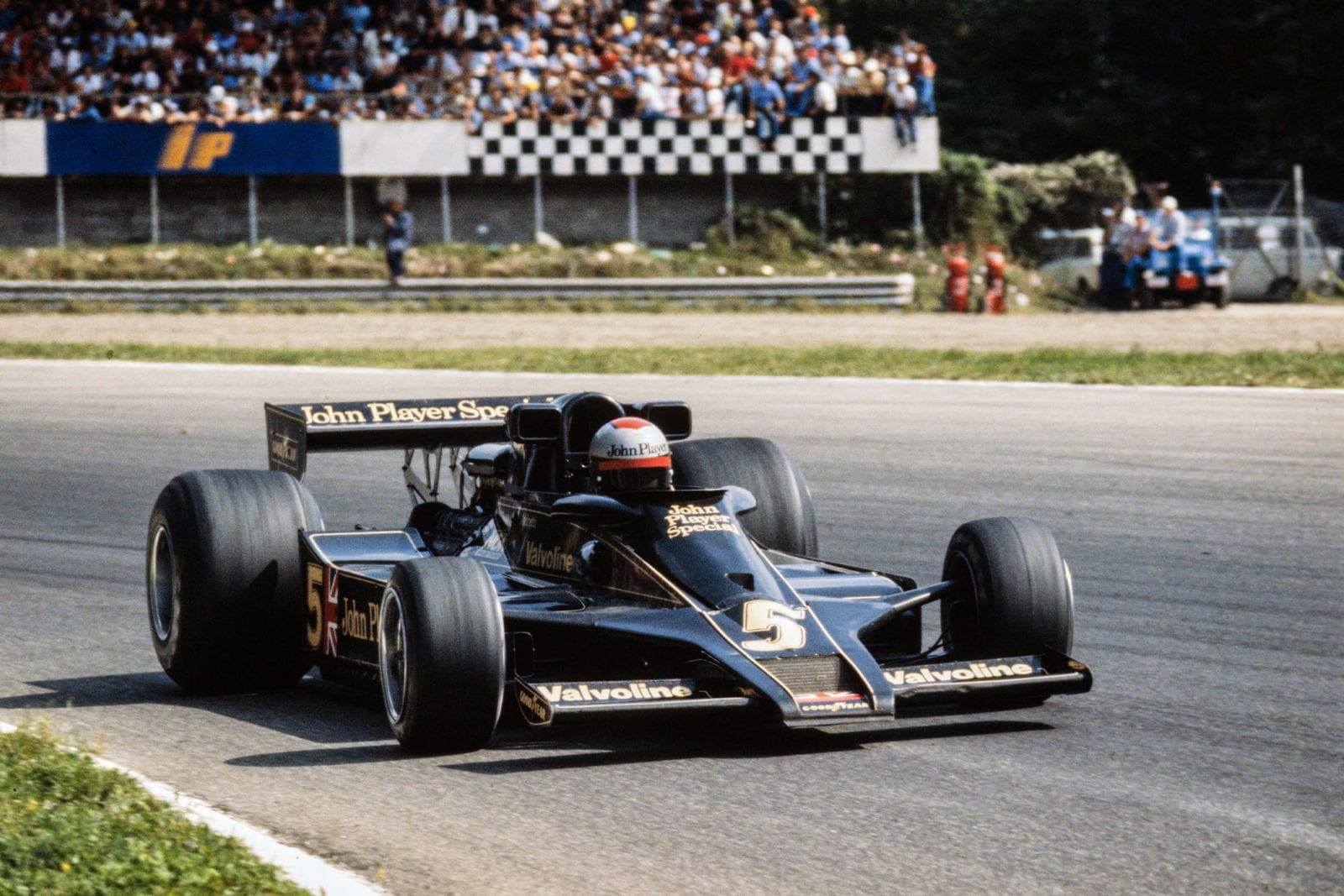
Mario Andretti on the way to his fourth win of the season
Motorsport Images
An Anglo-Italian victory
Monza, September 11th
Despite annual rumours that the race must be moved eventually owing to various local objections, legal sanctions or whatever, the Italian Grand Prix at Monza continues to be the final race in the European Formula One season. Over the years we have seen the Milanese circuits change and evolve in many ways, going from road circuit to a combination of road and banked circuit and then, when the banking began to deteriorate and prove too punishing for the frail Grand Prix cars of the early 1960s, it reverted to a pure road circuit once more. For more than ten seasons Monza was a “slipstreaming blind” where the drivers’ iron nerves and reliable machinery were more important than sheer skill; but that stopped in 1972 when two stupidly conceived chicanes were installed, one immediately after the pits and one at the Ascari curve. Fortunately, after a few years of silly spins, shunts and coming-togethers, the whole affair was redesigned for 1976. There’s now all ess-bend at the Ascari Curve, and two relatively easy chicanes, one before Curva Grande and one before the Lesmo curves. Now the cars come rushing out of Parabolica, fan out across the wide start/finish straight and rocket away on full song. You could happily sit in the main grandstand today and imagine there were no chicanes at all for the Italian Grand Prix!
Despite rumours that there might be a third Ferrari at Monza for the young American driver Eddie Cheever, the Maranello team brought along their usual trio of 312 tranversales for Niki Lauda and Carlos Reutemann. It was left to the Brabham team to pander to their Alfa Romeo engine suppliers by installing local hero Giorgio Francia in BT45/1B in the first practice session, even though team chief Ecclestone had assured everybody the previous week that he would be running only two cars in the Italian Grand Prix. In fact, he was right to the letter of his assurance, because Francia was allowed only a handful of painfully slow laps before Stuck commandeered it after the clutch centre plate sheared on BT45/3B. Another local driver making his first appearance in Formula One at Monza was Lamberto Leoni, the Young Italian who recently won the Formula Two Misano race in a Chevron-Ferrari V6, and he was installed in the second works Surtees TS19, recently vacated by the disillusioned Schuppan. Similarly the McLaren team gave Formula Two “ace” Bruno Giacomelli his Formula One debut in M23/8, in much the same way as they recruited Villeneuve for the British Grand Prix. at Silverstone.
Qualifying
Using Ferrari 312/031 Lauda opened off the first session in fine style on Friday morning, the Austrian driver clearly keen to prove that he is the driving force behind the current level of the Ferrari team’s competitiveness. He ended up fastest after the first hour and a half with a 1 min, 38.97 sec. best. It is a reflection on the progress made on the tyre front since last year that the 1976 pole position time of 1 min. 45.35 sec (established by Laffite’s Ligier-Matra JS5) was left behind very early on. Reutemann backed up his tearn-mate admirably with a 1 min. 39.18 sec. best and then came Watson in Brabham-Alfa BT45/5B on 1 min. 39.21 sec., which left a lot of happy cheering faces in the spectator grandstands, as one can imagine.
McLaren team leader James Hunt, for whom things simply don’t seem to have “clicked” in recent races, started off practice with the built-in handicap of having sprained a ligament in his right foot while playing in a football match in Switzerland earlier in the week. For a couple of days there were fears that he would not be fit enough to race at Monza, but by Friday morning his foot was feeling much better and he was able to practise M26/2 as usual. He managed a 1 min. 39.87 sec, which turned out to be sixth fastest overall on the day; but that was recorded in the team’s spare chassis in the second session after M26/2 had lost its oil pressure and forced its driver to leave it out on the circuit towards the end of the first session. As Hunt pointed out, he wasn’t at his most nimble with this foot trouble, so he was unable to sprint back to the pits quickly enough to use M26/1 for more than a handful of laps at the end of the morning.
Team Lotus were playing things cautiously to start with, using “standard” 470 b.h.p. DFVs in both their 78s for Andretti and Nilsson to start practice, although there were the usual plans to install one of the powerful development units in one of the cars (Andretti’s in this case) for the race. Andretti managed a 1 min. 39.45 sec. on Friday but Nilsson got himself rather confused experimenting with tyres, roll bars and chassis settings in general, and couldn’t get into the groove at all. His best was 1 min. 41.22 sec., which really wasn’t terribly impressive in the “overall order of things”, but you could see from the young Swede’s face that he wasn’t enjoying matters and realise that he wasn’t operating at peak form.
Hunt’s team-mate Mass managed 1 min. 40.77 sec., a fraction slower than Giacomelli achieved in the older M23. Jabouille’s Michelin-shod Renault RS01 proved that the French company is certainly making progress with its Formula One project by ending up eighth with an impressive 1 min. 40.06 sec. lap before a valve failure in the V6 engine stopped their practice and also meant tho they would be forced to miss the second session.
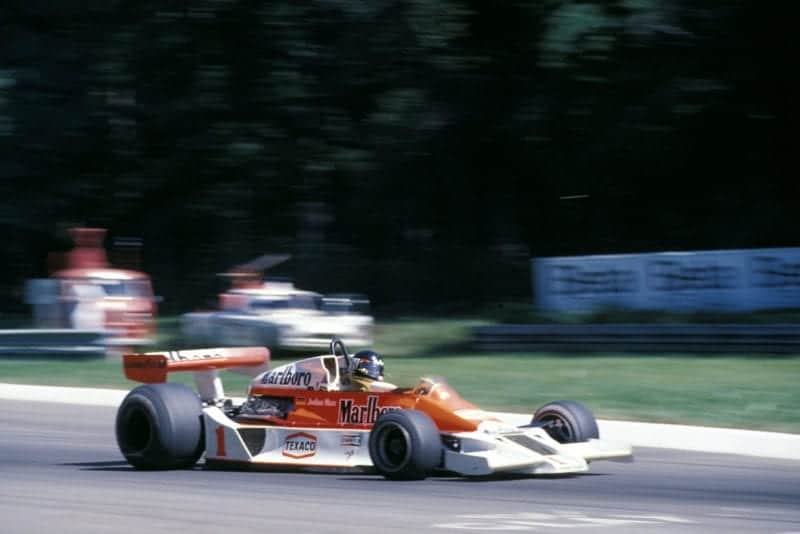
James Hunt secured pole in his McLaren
Motorsport Images
Further down the grid there was a combination of optimism and depression as some driver/car combinations proved less effective than they had hoped and others received a surprising “bonus”. One of the competitors in the latter category was local hero Clay Regazzoni, winner of two Italian Grands Prix for Ferrari (1970 and 1975), who found himself revelling in the power of a freshly rebuilt Nicholson McLaren DFV installed in his Ensign MN07. Monza was to be Regazzoni’s 100th Grand Prix race and he was anxious to do well, so he felt cautiously optimistic with a 1 min. 40.70 sec. best in a car that hasn’t been unduly noted for its straight line performance throughout the season. Slightly faster than “Regga” were both Vittorio Brambilla, uncharacteristically under control in his Surtees TS 19/06, and Jacques Laffite in his Ligier-Matra JS7/03, while both the Tyrrells managed times in the mid-1 min. 40 sec. bracket although neither Depailler nor Peterson could interpret these performances with any air of optimism. One gets the impression, both from the overall demeanour of the drivers and from the team, that the six-wheeler project is virtually over and everybody is simply “marking time” until the 1978 season arrives with a new car and at least one new driver.
In the Shadow team Jones had a hectic time on Friday, recording 1 min. 40.63 sec, before spinning off into the sand at one of the chicanes and sustaining suspension damage on his race car as the marshals pulled it out at the end of the session. He used the spare DN8 briefly before returning to his regular machine in the afternoon only to clip a chicane kerb and bend a suspension rocker arm. Patrese, the young Italian anxious to do well on home soil, recorded a 1 min. 41.87 sec. best before ignition failure left his stranded somewhere out on the circuit for much of the second session. After the success of the team in Austria, first Zandvoort and now Monza didn’t seem to be going the same way.
Down at the tail of the field there were all the regular “hopefuls” camped out on the grass at the far end of the pit lane, the poor relations of Formula One who are so far down the “pecking order” that they don’t get a proper pit or garage provided. ‘The Monza pits were built in the days when there were far fewer entries for World Championships Grands Prix, and their instigators could hardly have envised the number of cars we saw this year. What with spare chassis for the major teams, the pits are crowded from end to end, so the independents simply have to hope for the best and pray it doesn’t rain. One individual who metaphorically stuck two fingers in the air to this arrangement was that extrovert Italian, Arturo Merzario, who reckoned it was a damned poor show that he couldn’t have a pit for his home Grand Prix. Eventually, after a series of rows and discussions with both the Forrnula One Constructors Association and the organisers, Merzario stalked away in a paddy and withdrew his private March 761B, kaving behind him a very politely worded notice in the press room apologising to his fans and his sponsors but explaining the problem as he saw it.
Henton reappeared for a second outing in the now white-liveried Ensign MN04, operated by HB Alarm Systems, but a slipping clutch meant that he wasn’t in a position to do any competitive times on the first day, while Ian Ashley replaced Rebaque in the second FICA-entered Hesketh 308E alongside Keegan. Swiss privateer Loris Kessel appeared with an elderly, rebodied Williams FW/03 in an abortive attempt to get into the Italian race. Kessel, it will be recalled, drove a handful of races last season at the wheel of an ex-works Brabham-Cosworth BT44B, but achieved little in the way of hard results. The BRM P207S appeared yet again (devoid of sponsorship) for Teddy Pilette to practise, but it was too much to expect that the young Belgian would qualify the underpowered car from Bourne on a fast circuit like Monza.
March Engineering’s regular pair of entries for Ribeiro and Ian Scheckter turned up as usual, the South African driver getting into the swing of things slightly better with his newer 771/2 than previously, and the Bicester ranks were swollen as usual by Frank Williams’ private 761 for Neve. Lunger and Villota had their usual McLaren M23s, looking rather sheepish as one might expect when Giacornelli’s practice times were published.
Saturday morning’s untimed session was brought to an early stop after a short while when Tambay’s Ensign MN08 was involved in a huge accident coming round the first Lesmo curve. At a point where the French driver was just changing from third to fourth gear, the Ensign suddenly whipped sideways, hit the guard rail and flipped over onto its rollover bar, skating down the circuit for some distance in a shower of sparks. Most cars trickled into the pits, fearing the worst, and some stopped at the scene of the accident to lend assistance. Fortunately the Ensign is a stoutly built car (what else would you expect from a place like Walsall?) and Tambay had crawled out, unhurt, from the wreckage almost before the marshals had reached hint. Looking remarkably nonplussed about the whole affair, Tambay returned to the pits on foot and the Ensign team began fitting him out in Regazzoni’s spare MN06 for the afternoon session. Later in the morning Lauda “goofed” while trying out a set of “special” Goodyears, spinning his Ferrari into the barrier coming out of Parabolica and returning to the pits on foot to report minor rear end damage. The rear suspension of 030 was thus grafted onto the back of 031 for the final hour of practice, Reutemann switching to 312/029 for business on Saturday.
The final hour proved to be a tremendously exciting battle with the two Ferraris trying desperately to protect their front row grid positions from the combined assaults of Andretti’s Lotus, Scheckter’s Wolf and Hunt’s McLaren. Down tumbled the times into the low 1 min. 39 sec. bracket, then past Lauda’s Friday best and into the low 1 min. 38 sec. bracket. Within ten minutes of the end of the session it seemed certain that Reutemann would take pole position with 1 min. 38.15 sec. But Hunt slipped in a tremendous 1 min. 38.08 sec. to take pole position in the dying moments of practice, which prompted a great deal of smiling in the McLaren pit after their shameful treatment at the hands of the Italian organisers at last year’s Grand Prix.
Jody Scheckter improved to 1 min. 38.29 sec. after yet another bout of fuel pressure trouble which was traced to a faulty pressure relief valve, while Andretti secured the other place on row two with a strong 1 min. 38.37 sec. Lauda was just about to try for a “flyer” right at the end when his Ferrari started to misfire as it ran low on fuel, so he peeled off into the pits and had to settle for a 1 min. 38.54 sec., which put him on the third row. Alongside the Austrian’s Ferrari sat Patrese’s Shadow, after a fine performance from the Italian novice had resulted in him recording a 1 min. 38.683 sec. lap, one-hundredth of a second quicker than Regazzoni. Then came Laffile, Mass and Brambilla, while the “mid-field bunch” was led by Stuck and the two indifferent Tyrrell P34s. Neither of the Brabham-Alfa runners could get their cars to work on the rubber provided for them in the Monza heat, both Stuck and Watson suffering badly from tyre overheating problems that left them much further down the grid than one would have expected. Giacomelli did a very respectable job, splitting Watson and Jones, while Ian Scheckter was ahead of Nilsson and Jabouille, the Renault only getting out on the circuit late in the day after breaking another engine on Saturday morning. Nilsson just couldn’t get his Lotus adjusted to his liking while Tambay was feeling a little grey now that the full magnitude of his morning accident had struck him and was down at the back of the grid ahead of Lunger, Keegan and Neve, the last three qualifiers.
Race
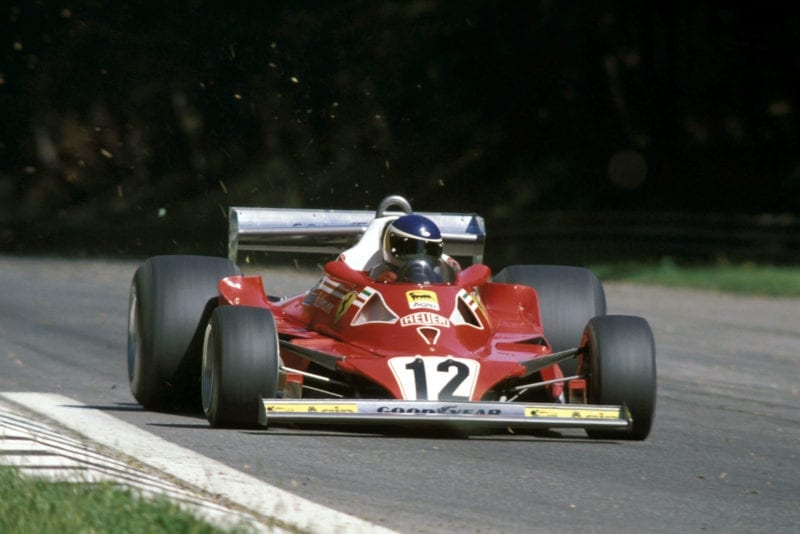
Carlos Reutemann started 2nd but spun off on lap 39
Motorsport Images
On Sunday morning the usual vast crowd poured into Monza from an early hour, banners in the public enclosures and grandstands obviously proclaiming allegiance to the Ferrari team with at least one begging Lauda not to leave Maranello to join the Brabham-Alfa set-up. Brambilla wrote off TS19/06 in the morning “warm up” at the first chicane, but as Leoni hadn’t qualified he took over TS19/07 for the race, while one spectator was killed and several injured when an advertising hoarding they were spectating from collapsed under the strain of too many people.
Eventually, almost half an hour prior to the half-past-three start, the cars trickled out onto their grid and Hunt defiantly took up pole position, refusing to be ruffled by the catcalls and jeers from the crowd. Slowly they departed on their pace lap and, bang on time the starting light turned to green to unleash the field. Hunt and Reutemann found themselves swallowed up by Andretti and Lauda as they sprinted down to the first chicane with Regazzoni bursting through to take a brief second place. Out of the chicane it was Scheckter’s Wolf in the lead, the young South African ace not messing about or waiting for anybody and extending his lead all the way round the first lap, emerging from Parabolica with a huge advantage over Hunt’s McLaren. Andretti had dived past Regazzoni at Parabolica and was third ahead of the Ensign, Reutemann, Lauda, Mass, Brambilla, Watson, Stuck, Patrese, Depailler, Peterson, Jones, Jarier, Giacomelli, Nilsson, Jabouille, Tambay, Keegan, Lunger, Ian Scheckter and Neve. Laffite’s Ligier had overheated on the grid and then stalled, so the French car was late away after attention at the side of the track, while the Renault had bashed its left nose spoiler against somebody’s rear wheel and this was now sticking up in the air. Laffite stopped at the end of his first lap for more water to be added, but the Ligier continued at the back of the field and raced on without any further problems all the way to the finish.
On the second lap Andretti shot past Hunt’s McLaren, leaving the Englishman to grapple with the two Ferraris, and made off after Scheckter. But the blue and gold Wolf was setting a tremendous pace and it took the Lotus driver a few laps to make any ground on Scheckter at all. Then, after about five laps, the Lotus pulled steadily closer to the Wolf until, on lap nine, he semmed all set to pounce. Anxious not to be over-enthusiastic in his passing manoeuvres (as he had been at Zandvoort), Andretti shadowed the Wolf closely for just over a complete lap before running calmly right round the outside of Scheckter as they came round Parabolica for the tenth time. A few laps of weaving to get the Wolf out of his Lotus’s slipstream and Andretti was away, never to be challenged again.
Meanwhile, there had been plenty of excitement going on further down the field. Watson, anxious to get up with the leaders, tried an over ambitious pass at outbraking Mass and Regazzoni as they rushed into the first chicane at the end of the opening lap. He misjudged the distance and slid, in a shower of dirt, across the kerbing on the right before crashing back onto the circuit. The damage had been done; an engine casting had been cracked and the Alfa flat-12 quickly began to overheat. Watson crawled sadly back to the pits to retire at the cnd of the second lap for the second successive race. Two laps later Nilsson came crawling in with a cracked suspension upright, the legacy of another nudging match, and Jarier’s Penske was soon in as well requiring a fresh nose section to be fitted before he could resume.
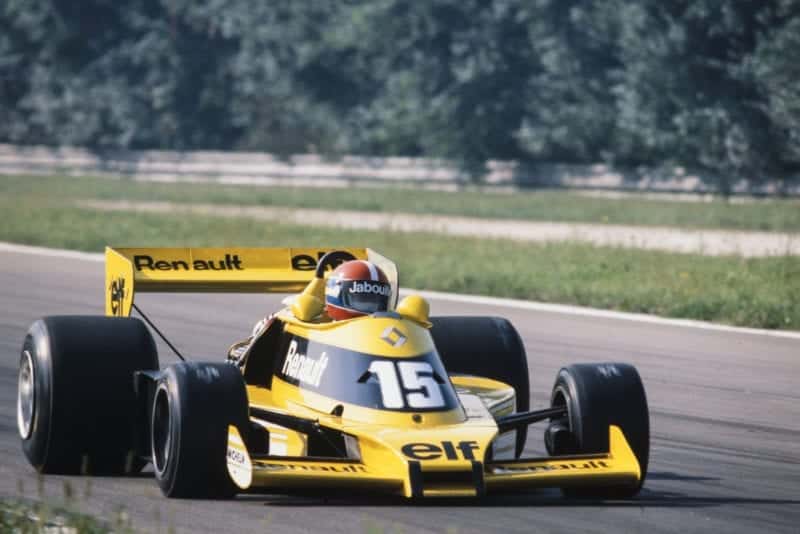
Renault returned with their burgeoning F1 car, but pilot Jabouille could not make it to the finish
Motorsport Images
As Andretti drove smoothly and confidently away from the Wolf, Hunt was having an increasingly hectic time fending off Reutemann and Lauda. During the morning warm-up the McLaren had been fitted with a harder compound left front tyre than had been expected owing to unexpectedly high indications of wear, and this had thrown the M26’s balance a little bit out. Hunt was having to work extremely hard to keep up and, when Jarier’s Penske appeared in the way they finished their 11th lap, Reutemann attempted to squeeze out the McLaren against the Frenchman as they came up to lap him. There wasn’t room for James to go through, so he spun off. The two Ferraris went through in third and fourth places, leaving Hunt to resume in eighth place behind team-mate Mass. He quickly passed the German driver, but then spun again before coming into the pits to have the front end of the car examined. Mechanics jacked up the M26, closely examining the brake pads and steering, before returning Hunt to the fray many laps down. He did just one flying lap before the brakes “went funny” and he spun again, this time not rejoining.
Monza certainly still shows up mechanical fragility, and engine failures came fast and furious. Lunger’s McLaren was out, its engine almost cut in two by a wayward connecting rod, on the fifth lap; Brambilla came in with overheating after picking up debris from Watson’s moment on lap 6, and Tambay’s Ensign succumbed on lap 19. Hans Stuck was doing his best for the Brabham-Alfa team and got up to fifth place, pursued by Jones’ Shadow which had come through well from its lowly grid position, while Patrese had dropped right back in amongst the mid-field runners after a peculiar moment out on the circuit when he found himself in neutral and took a few seconds to select any sort of gear.
On lap 23 the Renault finally stopped with engine failure, while any realistic pressure on Andretti evaporated next time round as Scheckter stopped the Wolf with engine failure out on the circuit. That left Andretti comfortably ahead of the two Ferraris, cruising smoothly round in confident style and hoping that his newly installed Cosworth development DFV wouldn’t let him down on this occasion.
The Alfa Romeo challenge ended on lap 31 when Stuck’s Brabham blew its enngine, but not before the press-on Alan Jones had moved his Shadow through into what was now fourth place. Fifth and sixth at this stage were Mass and Regazzoni ahead of Peterson, making the most of things with his Tyrrell. A few laps later Reutemann’s engine started to sound a little rough, the result of a cracked exhaust pipe, so Lauda took second place from his team-mate but the Argentinian hung on and kept close station behind.
On lap 39 the last major incident of the race occurred when Giacomelli’s McLaren blew its engine as it crossed the start/finish line. The little Italian driver continued down to the first chicane, leaving a swathe of oil in his wake before spinning on his own lubricant as he came out of the tight chicane. The two Ferraris were coming up to lap Giacomelli at that point and while Lauda saw the oil and moved to one side, Reutemann didn’t and spun quickly off the circuit into the sand. A few seconds later he was followed off the circuit by Patrese’s Shadow, which spun in exactly the same place, the DN8 striking a marshal but not injuring him seriously.
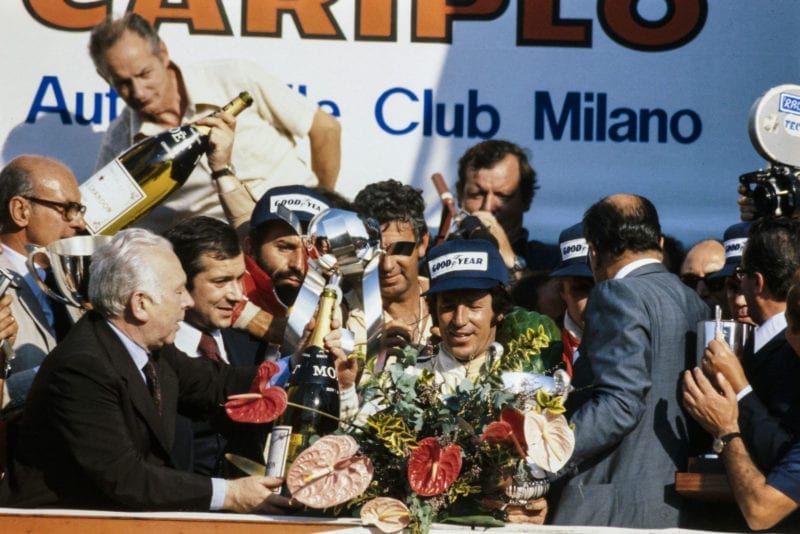
Andretti celebrates on the podium
Motorsport Images
From that point onwards any vestige of racing was over. Andretti reeled off the remaining 13 laps in superbly confident style to score a personally gratifying victory in front of a crowd that he considers to be made up of his compatriots. It was the fifth victory for Colin Chapman’s Lotus 78 (including Nilsson’s win at Zolder), an endorsement of the fact that Team Lotus are back in business in the best possible way. Lauda finished a steady second, to the accompaniment of cheers from the crowd, while Jones was a deserved third after a lot of hard work. Mass, Regazzoni and Peterson trailed across the line in the next three places while Neve was seventh, Laffite a hard-charging eighth and Keegan ninth and last after spinning his Hesketh a couple of times and making a pit stop as well. Not a great race by any means, but, to judge frorn the reaction of the crowd as they swarmed across the circuit on the slowing down lap, a very popular victory indeed. – A.H.
